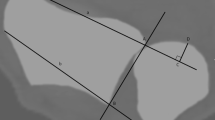Abstract
Bilateral wrist computed tomography (CT) was performed in 30 patients with suspected unilateral distal radioulnar joint (DRUJ) subluxation to evaluate dynamic DRUJ CT scanning with a straight elbow. Five CT criteria for diagnosing dorsovolar subluxation were examined. Maximum active supination and pronation on a conventional scanning table yielded satisfactory rotation (mean±SD, 119°±29°) at the DRUJ, thus permitting a dynamic diagnosis of DRUJ subluxation. The radioulnar line method and the congruity method frequently yielded false positive results compared with bilateral diagnosis and were unreliable. Modifications of these two methods achieved sensitivity and specificity comparable to the epicenter method. We recommend the modified radioulnar line method for diagnosing dorsovolar subluxation using unilateral CT because of its excellent sensitivity and specificity combined with ease of technique.
Similar content being viewed by others
Author information
Authors and Affiliations
Rights and permissions
About this article
Cite this article
Nakamura, R., Horii, E., Imaeda, T. et al. Criteria for diagnosing distal radioulnar joint subluxation by computed tomography. Skeletal Radiol 25, 649–653 (1996). https://doi.org/10.1007/s002560050152
Issue Date:
DOI: https://doi.org/10.1007/s002560050152




